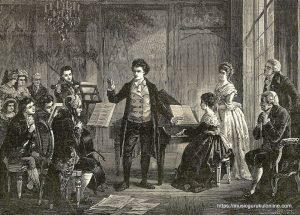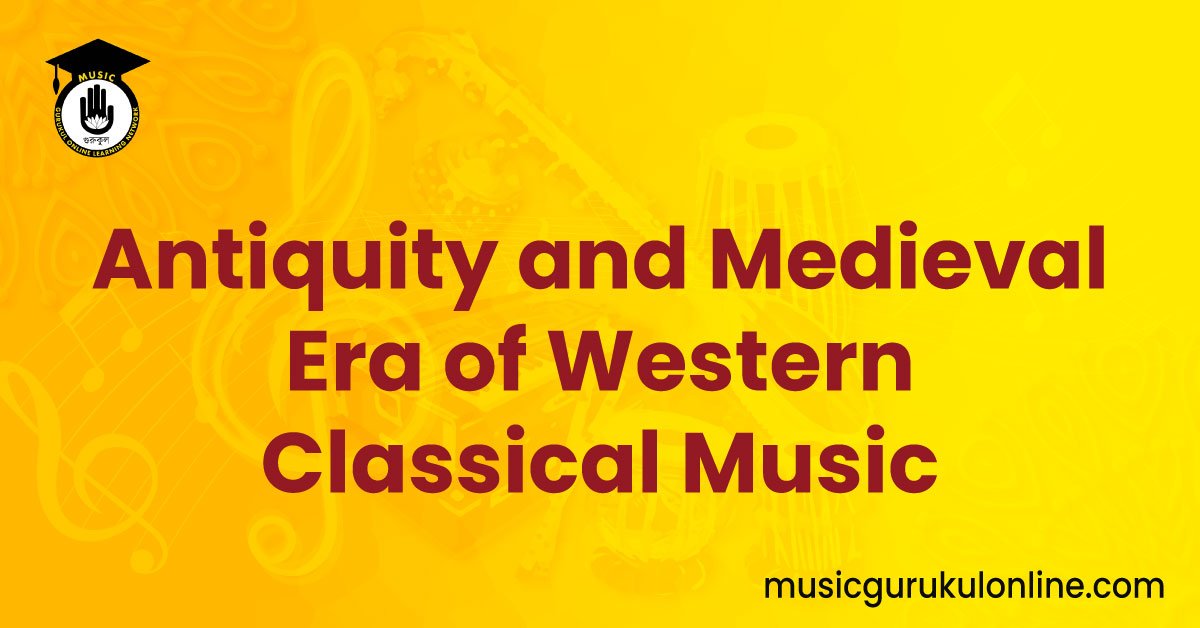Western classical music has a rich and diverse history that spans thousands of years, tracing its origins from ancient times to the present. The beginnings of this tradition lie in the intertwined worlds of the Greco-Roman antiquity and move through the intricate tapestries of the medieval era. Both these periods laid crucial groundwork for the development of music in the Western world.
Table of Contents
Antiquity and Medieval Era

1. Music in Antiquity
a. Ancient Greece
Music in Ancient Greece was considered an art form intertwined with mathematics, philosophy, and education. The Greeks believed that music had the power to penetrate the soul, influence one’s mood, and even shape character.
- Notation and Theory: The ancient Greeks used a system of notation known as “neumes”. Though not fully understood today, these neumes represented pitch and possibly rhythm. Pythagoras, the renowned mathematician, is credited with formulating the concept of musical intervals, establishing relationships between musical notes using mathematical ratios.
- Instruments: The most popular instruments were the lyre (a stringed instrument) and the aulos (a double-reeded instrument). The kithara, a larger and more elaborate form of the lyre, was also significant in ceremonies.
- Genres: Music permeated several aspects of Greek society. There were hymns dedicated to gods, odes sung in honor of victories, and dithyrambs that were choral songs dedicated to Dionysus.
b. Ancient Rome
The Romans adopted much of the Greek musical tradition but added their flair and innovation.
- Instruments: The Romans popularized instruments like the tuba, a long straight trumpet, and the cornu, a large curved horn. The hydraulic organ, known as the hydraulis, was another Roman favorite.
- Function: In Rome, music played a pivotal role in both private and public lives. It was central to celebrations, festivals, military parades, and even theatrical performances.
2. Transition to the Medieval Era
As the Roman Empire declined and eventually fell, Europe entered the early Middle Ages, also known as the Dark Ages. It was a period of political and social upheaval, with various tribes and groups migrating and establishing new kingdoms.
However, the Christian Church emerged as a beacon of stability during these turbulent times. Monasteries and churches became the centers of learning, and it was within this framework that the musical tradition of antiquity was preserved and transformed.
3. Medieval Music (500-1400 AD)
The Medieval Era in music is generally categorized into two main periods: the Early Medieval or pre-Gothic period (500-1150) and the Gothic period (1150-1400).
a. Early Medieval Music
- Plainchant (Gregorian Chant): Named after Pope Gregory I, Gregorian chant is a form of plainchant. It’s a single melodic line without accompaniment, characterized by its free-flowing rhythm and modality. Its primary purpose was to set Latin prayers to music, and it was performed by choirs of men and boys in churches.
- Neumatic Notation: The need to standardize chants across monasteries led to the development of a new system of notation. These early neumes indicated melodic contours but did not specify exact pitches or rhythms.
- Musical Institutions: Monasteries, cathedrals, and courts became the primary institutions supporting musical activities. Here, music was written, taught, and performed.
b. Gothic Period
- Polyphony: The most significant musical development of this period was the birth of polyphony, where two or more independent melodies were played simultaneously. The Notre Dame school in Paris became a focal point for the development and spread of early polyphonic music.
- New Notation System: As polyphony grew more intricate, there was a need for a more detailed system of notation. This led to the development of rhythmic modes, an early attempt to notate specific rhythms.
- Secular Music: With the rise of troubadours and trouvères in France and minnesingers in Germany, secular (non-religious) music became more widespread. These poet-musicians composed and performed songs on various themes, from chivalry and love to satire and political commentary.
- Instruments: Several instruments like the hurdy-gurdy, lute, rebec, and various forms of drums, bells, and flutes were in use. These were predominantly used to accompany songs or dances.
4. Summary
The Antiquity and Medieval Era of Western classical music laid the foundation for subsequent periods of musical evolution. From the philosophically-rich traditions of Ancient Greece to the emotionally profound Gregorian chants and the vibrant secular music of the Gothic era, these periods established musical norms, techniques, and forms that would be expanded upon in the Renaissance, Baroque, and Classical periods that followed.
Through intricate interplays between faith, philosophy, and artistic expression, the Antiquity and Medieval eras gave rise to music that was both a reflection of its time and a precursor to the diverse tapestry of Western music we recognize today. Whether in the hallowed halls of cathedrals, the bustling courts of kings, or the open squares of towns, music served as an emblem of cultural identity, spiritual devotion, and human expression.
In understanding the musical traditions of these periods, we not only gain insight into the historical and cultural nuances of the time but also appreciate the universality of human expression and the timeless power of music to resonate, inspire, and connect.
